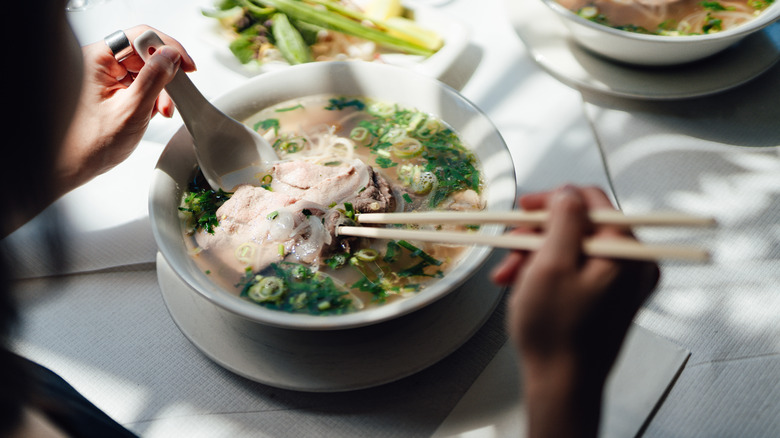The Mysterious History Of Vietnamese Pho
Vietnam has given us many amazing culinary creations, including the Vietnamese salted coffee, cà phê sữa đá. However, pho (also spelled phở) is by far the nation's most popular dish. This iconic soup is made with meat, usually beef, with rice noodles and herbs, all served in a bone broth flavored with star anise, ginger, black cardamom, coriander, and clove. While it might be Vietnam's national dish, its origins are elusive and, more likely than not, lost to history. Nevertheless, pho enthusiasts and food historians haven't stopped speculating about how this world-famous dish originated.
From what historians can tell, pho most likely originated from the province of Nam Dinh in the Red River Delta during the late 19th to early 20th century, when the country was under French control. Thanks to the French demand for beef, the meat became readily available, and it was added to bánh đa cua, while the surplus of beef bones found its way into stockpots for broths.
It's unclear what exactly transformed into pho, but some theorize it could have been a Vietnamese spin on the French pot-au-feu, a one-pot beef and vegetable stew, or a take on niurou fen, a Chinese beef and noodle soup. Another contender is xáo trâu, a Vietnamese dish made from water buffalo meat, broth, and rice vermicelli. While we can't know for sure, all of these dishes likely had some influence over the eventual creation of pho.
Pho's growing popularity and changes in the south
Although pho was created in Nam Dihn, it became popular in Hanoi during the 1930s, with pho vendors flooding the Old Quarter and serving the soup from mobile kitchens. However, the status quo was shaken up after the First Indochina War when Vietnam gained independence and was divided into two by the Geneva Accords in 1954. This saw roughly a million Vietnamese people migrating from the north to the south, bringing with them their recipes for pho.
In the south, chefs began making variations using the best beef cuts for pho while sweetening the broth and adding spice. In Saigon, many variations began popping up during the 20th century, thanks to the city's Cambodian and Chinese populations. Along with hoisin and soy sauce, some chefs began using Chinese rock sugar, radishes, Thai basil, bean sprouts, and fermented bean paste in their pho. Southern pho is all about bold flavors, while the north takes a more simplified approach to the dish.
Following the Vietnam War, the tradition of pho spread quickly as Vietnamese immigrants settled across the world. Today, pho is a culinary and cultural phenomenon, and if you know how to find the best Vietnamese restaurants, you're in for a real treat! If beef isn't your thing, there is also pho ga, made with chicken, and pho chey made entirely from vegetables.

